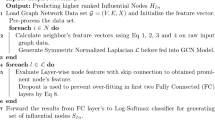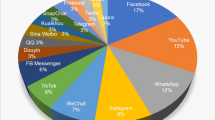Abstract
Identifying influential nodes is crucial for enhancing information diffusion in complex networks. Several approaches have been proposed to find these influential nodes based on the network structure that significantly impacts the node influence. Recently, several deep learning algorithms have also been introduced to identify influential nodes based on network exploration and node feature selection. However, this has led to challenges in enhancing efficiency and minimizing computation time. To address these challenges, we propose a novel framework called LCNN that uses convolutional neural networks and node-local representations to identify influential nodes in complex networks. We argue that we can measure node influence capacity using multi-scale metrics and a node’s adjacent matrix of one-hop neighbors to improve extracted information while reducing running time. According to the susceptible-infectious-recovered (SIR) model, the experiment results demonstrate that our proposed LCNN outperforms the state-of-the-art methods on both real-world and synthetic networks. Additionally, it exhibits a moderate time consumption, which makes it suitable for large-scale networks.
Graphical abstract
















Similar content being viewed by others
Data Availability
The datasets used and the code generated during the current study are available from the corresponding author on reasonable request.
References
Ai J, He T, Zhan S, Shang L (2022) Identifying influential nodes in complex networks based on spreading probability. Chaos Solit Fractals 164:112627
Barabási A-L, Albert R (1999) Emergence of scaling in random networks. Science 286(5439):509–512
Battiston F, Cencetti G, Iacopini I, Latora V, Lucas M, Patania A, Young J-G, Petri G (2020) Networks beyond pairwise interactions: structure and dynamics. Phys Rep 874:1–92
Boguná M, Pastor-Satorras R, Díaz-Guilera A, Arenas A (2004) Models of social networks based on social distance attachment. Phys Rev E 70(5):056122
Castellano C, Pastor-Satorras R (2010) Thresholds for epidemic spreading in networks. Phys Rev Lett 105(21):218701
Chen D, Lü L, Shang M-S, Zhang Y-C, Zhou T (2012) Identifying influential nodes in complex networks. Phys A: Stat Mech Its Appl 391(4):1777–1787
De Meo P, Levene M, Messina F, Provetti A (2019) A general centrality framework-based on node navigability. IEEE Trans Knowl Data Eng 32(11):2088–2100
De Nooy W, Mrvar A, Batagelj, V (2011) Exploratory social network analysis with Pajek, vol. 27. Cambridge University Press
Dorogovtsev SN, Goltsev AV, Mendes JFF (2006) K-core organization of complex networks. Phys Rev Lett 96(4):040601
Ewing RM, Chu P, Elisma F, Li H, Taylor P, Climie S, McBroom-Cerajewski L, Robinson MD, O’Connor L, Li M et al (2007) Large-scale mapping of human protein-protein interactions by mass spectrometry. Mol Syst Biol 3(1):89
Freeman LC (1977) A set of measures of centrality based on betweenness. Sociometry 35–41
Freeman LC (1978) Centrality in social networks conceptual clarification. Soc Netw 1(3):215–239
Guimera R, Danon L, Diaz-Guilera A, Giralt F, Arenas A (2003) Self-similar community structure in a network of human interactions. Phys Rev E 68(6):065103
Guo S, Zhou D, Fan J, Tong Q, Zhu T, Lv W, Li D, Havlin S (2019) Identifying the most influential roads based on traffic correlation networks. EPJ Data Sci 8(1):1–17
Hagberg A, Swart P, Chult DS (2008) Exploring network structure, dynamics, and function using networkx. Technical report, Los Alamos National Lab.(LANL), Los Alamos, NM (United States)
Hirsch JE (2005) An index to quantify an individual’s scientific research output. Proc Natl Acad Sci 102(46):16569–16572
Holzer B, Stegbauer C (2018) Bonacich, phillip (1987): Power and centrality: A family of measures. american journal of sociology 92 (5), s. 1170–1182. Schlüsselwerke der Netzwerkforschung 92(5):59
Kendall MG (1938) A new measure of rank correlation. Biometrika 30(1/2):81–93
Kermack WO, McKendrick AG (1927) A contribution to the mathematical theory of epidemics. Proc R Soc Lond Ser A-Contain Papers Math Phys Character 115(772):700–721
Kumar S, Kumar A, Panda BS (2022) Identifying influential nodes for smart enterprises using community structure with integrated feature ranking. IEEE Trans Industr Inform 19(1):703–711
Kumar S, Mallik A, Khetarpal A, Panda BS (2022) Influence maximization in social networks using graph embedding and graph neural network. Inform Sci 607:1617–1636
Kumar S, Mallik A, Panda BS (2023) Influence maximization in social networks using transfer learning via graph-based lstm. Expert Syst Appl 212:118770
Kunegis J (2013) Konect: the koblenz network collection. In Proceedings of the 22nd international conference on world wide web, p 1343–1350
Leskovec J, Mcauley J (2012) Learning to discover social circles in ego networks. Advances in neural information processing systems, 25
Leskovec J, Kleinberg J, Faloutsos C (2007) Graph evolution: Densification and shrinking diameters. ACM Trans Knowl Discov Data (TKDD) 1(1):2-es
Li S, Xiao F (2023) A mechanics model based on information entropy for identifying influencers in complex networks. Appl Intell 1–20
Liu Q, Wang B (2022) Neural extraction of multiscale essential structure for network dismantling. Neural Netw 154:99–108
Liu Q, Wang B, Qi J, Deng X (2022) A new centrality measure based on neighbor loop structure for network dismantling. Digit Commun Netw
Lü L, Chen D, Ren X-L, Zhang Q-M, Zhang Y-C, Zhou T (2016) Vital nodes identification in complex networks. Phys Rep 650:1–63
Maas AL, Hannun AY, Ng AY et al (2013) Rectifier nonlinearities improve neural network acoustic models. In: Proc. icml, vol 30, pp 3. Atlanta, Georgia, USA
Maji G, Mandal S, Sen S (2020) A systematic survey on influential spreaders identification in complex networks with a focus on k-shell based techniques. Expert Syst Appl 161:113681
Mnasri W, Azaouzi M, Romdhane LB (2021) Parallel social behavior-based algorithm for identification of influential users in social network. Appl Intell 51:7365–7383
Yang O, Guo Q, Xing J-L, Liu J-G (2022) Identification of spreading influence nodes via multi-level structural attributes based on the graph convolutional network. Expert Syst Appl 203:117515
Rezaei AA, Munoz J, Jalili M, Khayyam H (2023) A machine learning-based approach for vital node identification in complex networks. Expert Syst Appl 214:119086
Rocha LEC, Liljeros F, Holme P (2011) Simulated epidemics in an empirical spatiotemporal network of 50,185 sexual contacts. PLoS Comput Biol 7(3):e1001109
Rozemberczki B, Sarkar R (2020) Characteristic functions on graphs: Birds of a feather, from statistical descriptors to parametric models. In: Proceedings of the 29th ACM international conference on information & knowledge management, p 1325–1334
Rozemberczki B, Davies R, Sarkar R, Sutton C (2019) Gemsec: Graph embedding with self clustering. In: Proceedings of the 2019 IEEE/ACM international conference on advances in social networks analysis and mining 2019, p 65–72. ACM
Rual J-F, Venkatesan K, Hao T, Hirozane-Kishikawa T, Dricot A, Li N, Berriz GF, Gibbons FD, Dreze M, Ayivi-Guedehoussou N et al (2005) Towards a proteome-scale map of the human protein-protein interaction network. Nature 437(7062):1173–1178
Turpin A, Scholer F (2006) User performance versus precision measures for simple search tasks. In: Proceedings of the 29th annual international ACM SIGIR conference on Research and development in information retrieval, p 11–18
Ullah A, Wang B, Sheng JF, Long J, Khan N, Sun Z (2021) Identification of nodes influence based on global structure model in complex networks. Sci Rep 11(1):6173
Ullah A, Wang B, Sheng JF, Khan N (2022) Escape velocity centrality: escape influence-based key nodes identification in complex networks. Appl Intell 52(14):16586–16604
Wang M, Li W, Guo Y, Peng X, Li Y (2020) Identifying influential spreaders in complex networks based on improved k-shell method. Phys A: Stat Mech Its Appl 554:124229
Wang W, Street WN (2018) Modeling and maximizing influence diffusion in social networks for viral marketing. Appl Netw Sci 3(1):1–26
Wang Z, Changjiang D, Fan J, Xing Y (2017) Ranking influential nodes in social networks based on node position and neighborhood. Neurocomputing 260:466–477
Watts DJ, Strogatz SH (1998) Collective dynamics of ‘small-world’ networks. Nature 393(6684):440–442
Yang X, Xiao F (2021) An improved gravity model to identify influential nodes in complex networks based on k-shell method. Knowl Based Syst 227:107198
Yu E-Y, Wang Y-P, Yan F, Chen D-B, Xie M (2020) Identifying critical nodes in complex networks via graph convolutional networks. Knowl-Based Syst 198:105893
Zareie A, Sakellariou R (2022) Rumour spread minimization in social networks: A source-ignorant approach. Online Soc Netw Media 29:100206
Zhang M, Wang X, Jin L, Song M, Li Z (2022) A new approach for evaluating node importance in complex networks via deep learning methods. Neurocomputing 497:13–27
Zhao G, Jia P, Zhou A, Zhang B (2020) Infgcn: Identifying influential nodes in complex networks with graph convolutional networks. Neurocomputing 414:18–26
Acknowledgements
The authors would like to thank the editors and anonymous reviewers for their valuable comments that have helped to improve the paper.
Funding
This work is supported in part by National Nature Science Foundation of China (Grant No: 62172167).
Author information
Authors and Affiliations
Corresponding author
Ethics declarations
Conflicts of interest
The authors declare that they have no conflict of interest.
Additional information
Publisher's Note
Springer Nature remains neutral with regard to jurisdictional claims in published maps and institutional affiliations.
Rights and permissions
Springer Nature or its licensor (e.g. a society or other partner) holds exclusive rights to this article under a publishing agreement with the author(s) or other rightsholder(s); author self-archiving of the accepted manuscript version of this article is solely governed by the terms of such publishing agreement and applicable law.
About this article
Cite this article
Ahmad, W., Wang, B. & Chen, S. Learning to rank influential nodes in complex networks via convolutional neural networks. Appl Intell 54, 3260–3278 (2024). https://doi.org/10.1007/s10489-024-05336-x
Accepted:
Published:
Issue Date:
DOI: https://doi.org/10.1007/s10489-024-05336-x




